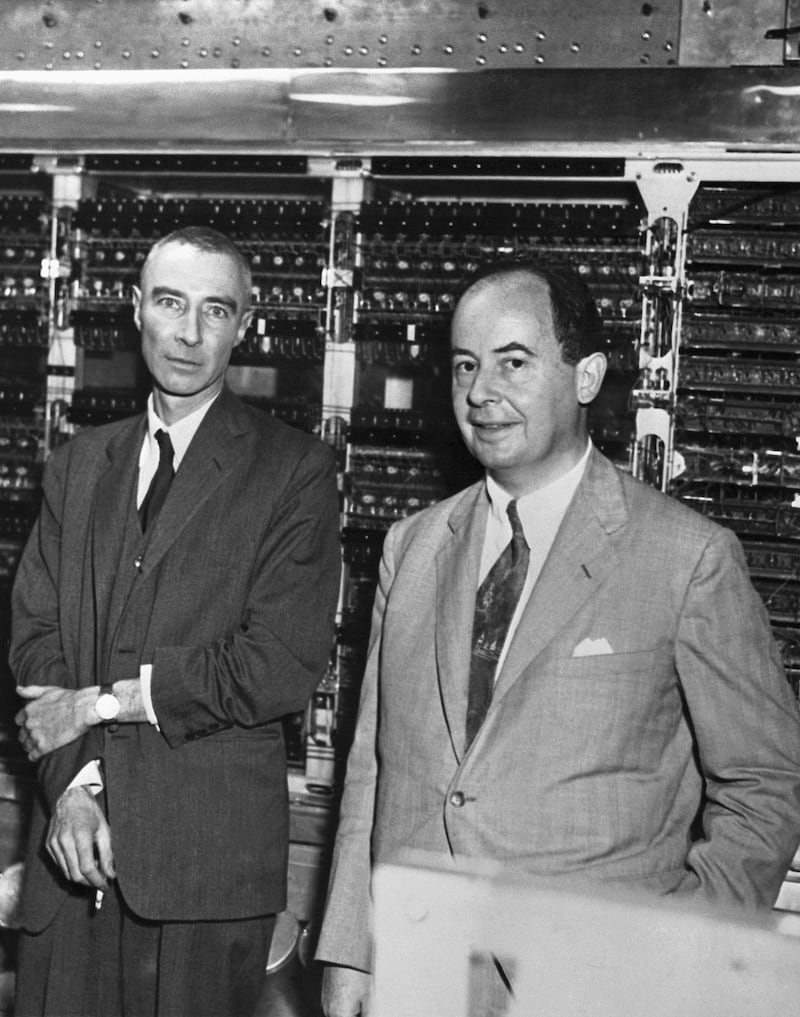“Why stop now,” to paraphrase Douglas Adams’s immortal Marvin the Paranoid Android, “just when we’re hating it?” Artificial intelligence, or a-life, has been entertaining us with its gloomy prognostications ever since Mary Shelley put quill to paper in 1818 in writing Frankenstein, and we’re still only getting started. Here are 12 of the best AI trailblazers in fiction, film and theatre from the past two centuries.
Frankenstein (1818)

The granddaddy of posthumanism, Mary Shelley’s Frankenstein; Or, the Modern Prometheus invented a genre with one galvanising blast of electricity, blending Lazarus and the legend of the Golem to create the first artificially created life to be endowed – or afflicted – with needs, wants and desires. Forget the clanking Hollywood monsters and Boris Karloff stomping about: Frankenstein’s “creature” is all too human, and the novel is a heartbreaking work of genius that persuasively delivers the first terrifying glimpse of a future in which technology begins to break the bounds of its creators’ control.
RUR (1920)
Or, Rossum’s Universal Robots. Karel Capek’s play coined the word robot – the Czech for serf – in a drama that envisaged an uprising of artificial life against its human creators. There’s no clanking here, either: organic creations who physically resemble humans, the robots eventually have enough of doing the heavy lifting and turn on their creators, only to discover that the creativity required to generate their kind is a uniquely human gift. Capek was unsuccessfully nominated for the Nobel Prize in Literature no fewer than seven times; still, it’s the coining of “robot” that ensures his immortality. Recently published by MIT Press, and edited by Jitka Cejkova, Karel Capek’s RUR and the Vision of Artificial Life is essential reading for the a-life enthusiast.
Metropolis (1927)
The clanking begins. Adapted from Thea von Harbou’s 1925 novel, and set in 2026 (yikes!), the aesthetic of this pioneering sci-fi was heavily influenced by director Fritz Lang’s first impressions of 1920s Manhattan. We’re in a futuristic dystopia, of course, because futures are dystopian to a fault, in which capitalist swine oppress the humble workers. Boo, says the idealistic Freder, who is in love with the beautiful worker-saint Maria, who becomes a rebellion-inciting robot who unleashes havoc on the industrialised society. Hurrah for robots!
READ MORE
I, Robot (1950)
But would the radical idea of human and a-life finding common cause catch on? It would not. Indeed, things eventually got so fractious that Isaac Asimov was obliged, in this collection of short stories, to outline the Three Laws of Robotics, which theoretically eliminated a robot’s ability to harm a human, even by inaction. Alas, where there’s a will – even a positronic will – there’s a way, and I, Robot (along with a slew of sequels) documents the many, many ways in which a-life might deliberately, accidentally or simply by adhering too literally to the rules cause humans to come to grief. Blame the human programmers who somehow failed to anticipate every potential wrinkle in life’s great tapestry.
Solaris (1970)
Adapted for film by Andrei Tarkovsky (1972) and Steven Soderbergh (2002), Stanislaw Lem’s novel finds astronaut Kelvin arriving on the space station Prometheus (oo-er!), which is in orbit around the eponymous planet. There he encounters his wife, Rheya, even though, to the best of Kelvin’s knowledge, Rheya died some years previously. Rather more tactile than hallucinations tend to be, Rheya seems to have no awareness of who she is – might Solaris itself be responsible for generating this artificial life? And why? Here hard sci-fi meets existential philosophy – but you’d have to say metaphysical speculation is the real winner.
Robot (1973)
Lem’s fellow Pole Adam Wisniewski-Snerg published Robot a couple of years later, his ambition, it seems, to write the most narratively dense sci-fi novel ever. Hats off to him, then, for this yarn about BER-66 (who may or may not be a robot) attempting to defy “the Mechanism” on a miniature, labyrinthine world recently detached from its home planet and currently barrelling through the trackless wastes of space at a significant fraction of the speed of light. A metaphor for life under Soviet rule? Probably. To say that a reread will prove rewarding is to significantly understate the case: it’s more accurate to say that Robot can only be fully appreciated by a reader possessed of multiple PhDs in cosmology, theoretical physics and advanced paranoia.
Blade Runner (1982)
Sometimes – heresy alert – the movie is better than the novel. Adapted from Philip K Dick’s Do Androids Dream of Electric Sheep? (1968), Ridley Scott’s Blade Runner still looks futuristic. Harrison Ford stars as the eponymous bounty hunter, Deckard, who leaps into action when a group of rogue replicants, led by Roy Batty (Rutger Hauer), arrive on Earth hoping to have words with the creator who designed them with built-in obsolescence. Whether Deckard is himself human or android is a cause for contention but actually irrelevant: what makes Blade Runner such a wonderfully poignant sci-fi is the furiously blazing desire to live that fuels Roy Batty’s doomed rebellion. All together now: “I’ve seen things you people wouldn’t believe ...”
Neuromancer (1984)
William Gibson doesn’t do things by halves, so it’s no surprise to find that Neuromancer, the first of his Sprawl trilogy, is fairly teeming with examples of a-life. The story follows the “virtual cowboy” Case, a computer hacker, as he teams up with Molly, a cyborg, to carry out a series of crimes, during the course of which he encounters a host of robots, artificial intelligences and trans- and posthumans, many of whom have been technologically advanced according to the theories still current when Gibson was writing the novel, in the early 1980s. From bodiless computers to identities enhanced and uploaded into organic hosts, Gibson’s characters pretty much cover the gamut of what is theoretically possible when the tentacles of hard science begin colonising the soft machine.
The Terminator (1984)
“I’ll be back,” the Terminator (Arnold Schwarzenegger) tells an unsuspecting cop in James Cameron’s blockbuster, and he didn’t disappoint. The Terminator franchise might have returned to the well a couple of times too often, but the original still retains its power as a brutally stark metaphor: the future is coming, and it won’t be pretty. Schwarzenegger was perfectly cast as the implacable, unstoppable and seemingly unkillable cybernetic assassin that is wholly unaware of such human niceties as morality and compassion as he relentlessly pursues the child he is programmed to kill. The future, eh? Why does it always have to be so blummin’ dystopian and postapocalyptic?
Wall-E (2008)
Which brings us very neatly to the cute’n’cuddly Waste Allocation Load Lifter: Earth Class, or Wall-E for short. Set in 2085 on an Earth that ecocide has made uninhabitable for humans, the film begins with the little robot Wall-E bumbling around the planet salvaging parts from other robots with only his pet cockroach for company. Fond of watching the musical Hello Dolly! on videocassette (oh, the humanity!), Wall-E’s grim existence is enlivened one day when he encounters the egg-shaped Extraterrestrial Vegetation Evaluator, or EVE. Can robots experience love? Pixar robots certainly can, which is good news given that Pixar will likely end up running the planet one day.
Autonomous (2018)
When William Gibson hails a novel as thrillingly new, you know you’ve hit the motherload. Set on Earth in 2144, Annalee Newitz’s tale focuses on Jack, an anti-patent scientist gone rogue and operating (from a submarine, natch) as a kind of futuristic Robin Hood, manufacturing affordable medicines for the poor and disenfranchised in a world ruled by consumerism and greed. Hunting her down are military agents Eliasz and his robot sidekick Paladin, neither of whom understands the tenuous bond that appears to be forming between them. As the title suggests, Autonomous is a meditation on free will, agency and the concept of freedom itself. Are robots doomed to become the slaves of the next generation? And, if so, how long are they likely to stand still for it?
The Maniac (2023)

A mathematical genius and the creator of the self-replicating machine, and so the godfather of artificial intelligence, the Hungarian-born John von Neumann is the subject of Benjamin Labatut’s novel, which blends fact and fiction as Labatut explores, via experimental maths and physics, von Neumann’s relentless pursuit of the impossible. The first man to establish a mathematical framework for quantum mechanics – no mean feat in itself – von Neumann would go on to push the human mind beyond the frontiers of rational thought and into a realm in which artificial intelligence developed the potential to outstrip its human creators. Which hasn’t yet happened at the time of going to print but may well have occurred by the time you read this online, in which case let me be the first to roll out the digital red carpet for our a-life overlords. Hail!

















